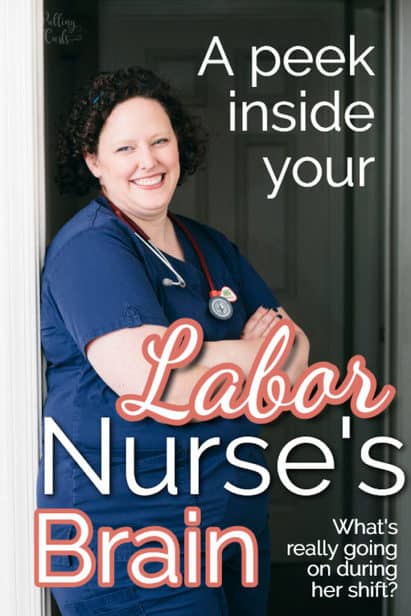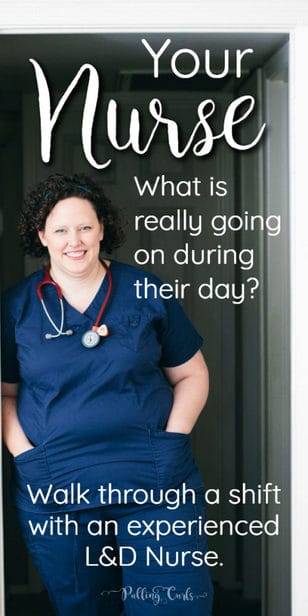A nurse’s day is long. Often extremely rewarding, but ALWAYS exhausting. Today, I want to give you a peek into my day, but also where my brain is as we extend through a twelve-hour shift, with my new bff — my patient(s).

07:00 we glide out of the break room. Fresh blood is on the unit, and never were there happier eyes than the night shift to see us (until our eyes meet theirs in 12 hours from now). We each pair up with the person whose patient(s) we are receiving and head into the rooms.
Just recently we’ve started bedside report. Studies have shown there are better outcomes when we give report in front of a patient. It helps patients know what we’re saying about them, and every now and then we get a juicy nugget that we didn’t get in the admission process (it really helped that we were educated on the why when we started doing this new process — education is so important).
Sometimes we share some technical stuff that you won’t want to know as we walk down the hall into the room (like if the doctor will be in surgery that AM or if you have information you don’t want to be shared with your family).
Patient privacy is very important to us, but it is also important to us to share your info with the people you want it shared with (husband, mom, etc). It’s always a balance. Just starting on the tightrope we walk all day long.
In report, I hear that you’ve been coping with the pain quite well until recently, and you are starting to consider an epidural.
As soon as we’re done reporting off, I take over and do a quick assessment. We’re going to be together through one of the most traumatic processes your body is going to go through. It is very important for me to have a baseline before we get an epidural and progress into labor deeper.
FYI, This is a sponsored conversation written by me on behalf of BoardVitals. The opinions and text are all mine. I am grateful for companies like Boardvitals who want the public to really know all the training, blood sweat and tears that go into a profession like my own.
For me, this year is my year of education. I have notes on my calendar for NRP (Neonatal resuscitation) and ACLS (which is where nurses learn how to help people who’s hearts have stopped). I have taken both of these classes about 9 times each at this point, but every time I learn something new. It’s amazing that we’re achieving better outcomes through training like this. Besides this, I am constantly staying up to date with new medications we’re using and changing workflows to help moms & babies stay healthier/bond better.
It is exciting to be able to use the things I’m learning to enhance that! If you’re a medical professional and are in need of recertifications or preparations for tests, check out BoardVitals to help you prepare! They have 7% higher pass rates, with 18% less study time and clearly, love their students!

Ok, back to my patient’s and the epidural you want! After my quick assessment, I start your IV bolus and go to find anesthesia. I’m grateful that most doctors let patients have an epidural when they want it, vs when I started almost 20 years ago when patients would beg to get one on deaf ears sometimes. 🙂
Anesthesia is also fresh. We have some of my favorite anesthesiologists. They’re good, they’re caring and they’re calm. Some of the best characteristics of an anesthesiologist.
Did you know that the Anesthesiologist is basically the king of our unit? When the crap hits the fan, he’s in charge. He gives orders and we carry them out.
Nope, they don’t deliver babies. But when something goes wrong they are our rock. I appreciate each and every one of them, and a calm anesthesiologist makes everything run more smoothly.
Which is a blessing for all of us, especially our patients.
Anesthesia comes in. It’s almost like a ballet dance. I know what they expect, and I’m helping the patient follow instructions. I’m putting on monitors and putting everyone at ease.
I know you’re nervous. I know you wonder if it will hurt more than you’re hoping for. I know you want reassurance that things are going OK. I get that, I know that — and I want to be there for you. Of course, I also have to get 900 million things ready and watch vital signs and babies. All in a day’s work.
This is why I’ve heard it takes 2 years to get a labor nurse up to par, and about 8 years to feel proficient. I’d agree with that. I am headed into year 19.
The epidural goes in and you start feeling warm and tingly in your feet. You worry that one foot is getting denser than the other, but I say that’s normal and we’ll move you around to make sure the medicine gets to all the spots — thanks to our friend, gravity.
I hang out with you for a bit while the blood pressure cuff strangles your arm. Yes, I know it’s annoying, but way less annoying than dying or living without an epidural so we each cope with it right now. I chart basic vitals every 2 minutes right now and do a basic assessment every 15 minutes. I’m also watching your blood pressure and your baby like a hawk to see if anything is changing and if I need to adjust anything.
The major issue with an epidural is that your body is sinking into bliss. When that happens, your blood pressure sometimes drops, and it’s my job to keep the bliss going.
#keepthebliss 🙂
I go empty your trash and take a sip of water. I check out the rest of the unit. A good nurse gets a pulse of the whole unit so she is available to help if someone needs it. I like to know the basics of what’s in each room, as we are all nurses and can be called to act in any room and at any time.
Then, it’s back to you to put your catheter in. Your brand new urine purse hangs in your bed and keeps your bladder from getting in the way of the baby exit area.
While I’m there, I check your cervix and find that your relaxation has taken effect in your cervix as well and the baby is progressing nicely. We should have a baby in a few hours.
I take some time to tidy up your room and make sure baby is doing alright post-epidural and I head out to the nurses’ station to take a peek at your prenatal record. Doctor’s fax us what happened in the office during all your prenatal visits. Sometimes we find new info in there, so I like to glance at it when I have time.
Sometimes at this point, I get another patient or I do a triage visit, or — if the angels smile I run to the cafeteria to get some breakfast. I’m up for whatever, and I always carry cashews in my bag should the need arise.
Either way, my new job is to chart on you every 15 minutes. Your vitals, baby’s vitals, what your uterus is deciding to do. I may also start some Pitocin if your doctor wants it. That might speed labor along a bit. Doctors like babies who are born before sleeping hours. I can’t blame, them, but I’m also a fan of letting babies make their own way.
However, my vote isn’t very important in this election.
You, my patient on the other hand, need to always keep in mind you have full veto power. If, at any time you don’t want something — you can say you prefer not to, and we can either wait or talk about it — or I can call your doctor. I want you comfortable with what we’re doing.
It makes both of us happy that way.
I ease into my new rhythm of charting and getting things ready for delivery.
Every hour I turn you, your numb lower limbs often needing some help to get them where I want them to be. Sometimes we use a peanut ball or pillows to position your hips in a way that keeps them open.
When I notice baby having some heart rate dips I check your cervix and find that you’re complete. We’re both thrilled and I call your doctor who tells me she can’t come right now, and we need to wait.
That’s right, hurry up and wait. That’s how it goes.
But I’m like a boy scout. I want everything we’ll ever need in that room. I go through mental checklists of what we’ll need and I talk to the nurse who’s going to help with the baby to make sure we’re on the same page.
Finally, the doctor calls and says we can push.
If this is your first baby we’re looking at a likely 2 hours of pushing. But if you’ve had a baby before, we hope for less time. Sometimes, my funny disposition is enough to get a baby moving, if you know what I mean.
We start pushing, and I am grateful the baby is coming down well. This might not be too long.
I hate pushing almost as much as you do, so I try to keep that session short.
Even while we push, I alternate between checking your vitals, baby’s vitals, and running through the checklist of things we’ll need.
Finally, the doctor comes and we have a baby.
While you have all the feels of your new baby, I spring into action.
I’m watching your new baby (along with a baby nurse), giving attention to the needs of the doctor, watching bleeding. In fact, in the last couple of years, there has been a new drug for bleeding that really helps! It’s crazy how, even after all the time I’ve done this job, we are still making advances. TXA is making advancements in postpartum hemorrhages for pennies on the dollar. But, every new drug means new training.
It’s exciting to see these types of advancements at work.
My mind continues bouncing between baby, doctor, and you, along with an eye on vital signs. You ask for juice as I’m thinking if your bleeding is too much, if a clot is too large. You think of me as a waitress while I am really the eyes and ears of life-saving medicine. And yet, I’m both.
The juice comes, and I check bleeding. I help the baby latch on, I clean poop. It’s all in a day’s work.
I start the absolute piles of charting that I have at your bedside. I “Ooo”, and “ahh” of the tiny fingers and toes. I take seconds out to take a swig of my own water and assess what needs to be done.
Each time we talk, I try to teach you something new about your new baby. You find it to be casual conversation, but I’m building a foundation of motherhood that will help you raise this new human.
And just like that, your two-hour recovery is up. It’s time for you to pee (fingers crossed it actually happens). Your unstable legs put onto a weird device that wheels you into the bathroom. I help you put on panties and pads. You feel ashamed that you can’t do simple things on your own, but I know someone did it for me, and I am happy to do it for you. I teach you the new wonders of your swollen bottom, and how to get it back to how it used to be.
Your new normal is my every day.
I wisk you to a new room, with new nurses and the ability to be on your own a bit more.
You’re grateful for a clean, softer bed. I’m grateful for new nurses who specialize in after delivery.
Of course, I walk back to my unit and do it all again. A new uterus ready to expel its contents.
It’s a wonderful, amazing day. It takes training far beyond what you’ll ever see. I’m grateful for the teachers who have taught me so I can help you. Always learning, always working, always watching to see if there are any problems. It’s second nature at this point.
And, of course — if you’re a medical professional, you should visit www.boardvitals.com to learn more about how they can better prepare you for ongoing exams. Their all digital content is up to date (unlike that nursing textbook I’ve been hauling around) so your patients can get the best care from you.
BoardVitals helps practitioners prepare for licensing and initial certification exams, maintenance of certification (MOC) requirements, and continuing professional education, covering more than 50 specialty areas. On select question banks, physicians can study for their board exam and earn CME credits simultaneously — which, combined with decreased study time is a total win!
Thanks for reading this post, photo credit to Photography Hill (love her) — feel free to join my pregnancy series — and, feel free to check out my other pregnancy posts:
[pt_view id=”0fae3f0c8d”]






Indra Johansson-Matthews says
Good Afternoon Hillary!
I really enjoyed your article and seriously considered posting it on Facebook. The only reason I won’t is because many of my colleagues would think I had gone nuts!!
You see, I am a RN that went on and became a CRNA. CERTIFIED REGISTERED NURSE ANESTHETIST. I do the exact same job that an anesthesiologist does in a critical situation. I do anesthesia for crash C/S’s, I manage PPH, PRE-eclampsia, I have done a million epidurals in my 30 year career, and yes, I was an ICU than an ER RN prior to that.
Currently I am working independently at a hospital in Napa California. This is my 3rd day on and I am it for anesthesia services for the OB floor. I am here 24/7. No one calls me in from home. I have had a baby before so there is no dragging my feet to reside an epidural.
I don’t know if you have worked with CRNA’s before, but I hope you get to in the future! Over half of the anesthetic sin this country are done by CRNA’s. Before the wars, anesthesia was always done by nurses. It was only after the wars when the MD’s realized that they could make it very lucrative that they made it a medical specialty. And now there is constant conflict, which I find super unfortunate.
Many CRNA’s work in rural area’s where the MDA’s don’t want to go or live because of the pay.
We on average make about half of what an anesthesiologist does and we do the exact same job.
I am a nurse and love doing anesthesia for my patients. We have a lot of training that physicians don’t. I just giggle when I see new residents try to interact with patients. They are so stiff and awkward.
Just wanted to give you a new way to look at things. On the OB floor, the Anesthesiologist isn’t always the King or Queen!!
Hilary Erickson says
I have actually never worked with a CRNA…. which is sad, but I guess they don’t do OB in our area. But, I’m sure when the shiz hits the fan you’re just as capable! 🙂
Sue Winters, RN says
Hilary,
Thank you so much for writing this article! I saw it come across my notifications the other day and scheduled time to read it this morning. So goes the life of a mom, nurse and blogger right? It was excellent. L&D nurses have super powers I swear. My OB/GYN better half says all the time OBs couldn’t do their jobs without amazing L&D nurses. You have so many jobs to do all at once and patients look to and trust their nurse and labor hurts. A good experienced, calm, no-nonsense L&D nurse is a Godsend to both the patients and physicians.
I think bedside report works really well. You have eyeballs on the patient, already assessing what you are seeing, and it is less likely important information will be left out. It eases the patient’s anxiety and can help the patient feel more in control of their labor. I worked in a facility for a few years where the charge nurse on the unit did rounds on every patient with the doctor covering the unit too, and basically gave report again to the physician right at the bedside. It was an interesting model.
Checked out BoardVitals! Looks like an amazing resource! We will be sharing this site with students we tutor and with faculty friends in case, their students don’t know about it.
Thank you,
Hilary Erickson says
Thanks so much Sue! Sometimes I wish we had more super powers. 🙂 Appreciate your comment!